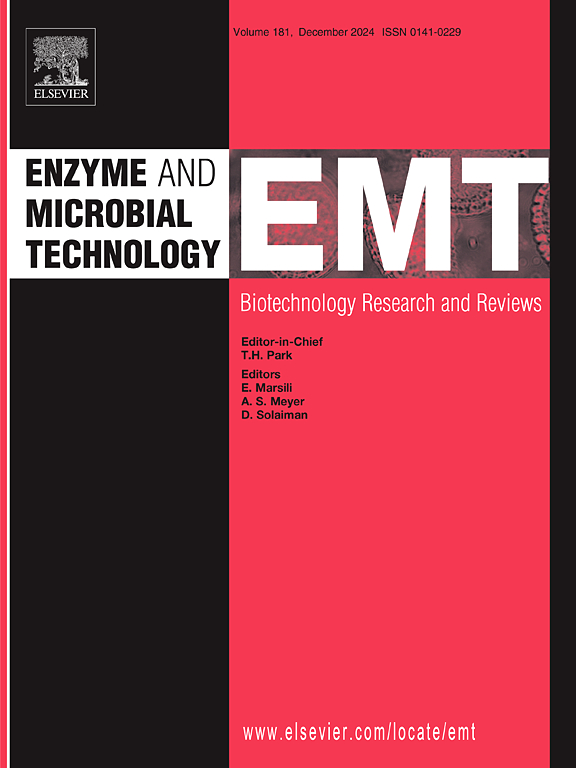Microbial community dynamics and functional potential during the natural fermentation of rose: A metagenomic and volatile compound analysis
IF 3.7
3区 生物学
Q2 BIOTECHNOLOGY & APPLIED MICROBIOLOGY
引用次数: 0
Abstract
This study investigates the dynamics of microbial communities and their functional characteristics during the natural fermentation of roses. Utilizing metagenomic sequencing and volatile compound analysis, the research elucidates the succession of microbial communities and their relationship with the flavor compound production. The findings indicate that Klebsiella and Pichia are predominant in the early stages of fermentation, while Acetobacter and Cyberlindnera become more abundant in the middle and later stages. The glycosyltransferase (GT) family is identified as the primary carbohydrate-active enzyme (CAZy) family involved in fermentation, with GT1 and GT2 exhibiting a higher gene abundance. Functional genes are predominantly associated with the carbohydrate and amino acid metabolism. Analysis of volatile compounds reveals that substances such as phenethyl acetate and (S,S)-2,3-Butanediol are closely related to the structure of the microbial community. These findings contribute to a deeper understanding of the mechanisms underlying rose fermentation and offer a theoretical foundation for technological advancements in the rose product industry.
玫瑰自然发酵过程中微生物群落动态和功能潜力:宏基因组和挥发性化合物分析
研究了玫瑰自然发酵过程中微生物群落的动态变化及其功能特征。利用宏基因组测序和挥发性化合物分析,研究了风味化合物生产过程中微生物群落的演代及其与风味化合物生产的关系。结果表明,克雷伯氏菌和毕赤酵母在发酵的早期阶段占优势,而醋酸杆菌和赛博林纳菌在发酵的中后期更加丰富。糖基转移酶(GT)家族被确定为参与发酵的主要碳水化合物活性酶(CAZy)家族,其中GT1和GT2表现出更高的基因丰度。功能基因主要与碳水化合物和氨基酸代谢有关。挥发性化合物分析表明,乙酸苯乙酯和(S,S)-2,3-丁二醇等物质与微生物群落结构密切相关。这些发现有助于更深入地了解玫瑰发酵的机制,并为玫瑰产品工业的技术进步提供理论基础。
本文章由计算机程序翻译,如有差异,请以英文原文为准。
求助全文
约1分钟内获得全文
求助全文
来源期刊

Enzyme and Microbial Technology
生物-生物工程与应用微生物
CiteScore
7.60
自引率
5.90%
发文量
142
审稿时长
38 days
期刊介绍:
Enzyme and Microbial Technology is an international, peer-reviewed journal publishing original research and reviews, of biotechnological significance and novelty, on basic and applied aspects of the science and technology of processes involving the use of enzymes, micro-organisms, animal cells and plant cells.
We especially encourage submissions on:
Biocatalysis and the use of Directed Evolution in Synthetic Biology and Biotechnology
Biotechnological Production of New Bioactive Molecules, Biomaterials, Biopharmaceuticals, and Biofuels
New Imaging Techniques and Biosensors, especially as applicable to Healthcare and Systems Biology
New Biotechnological Approaches in Genomics, Proteomics and Metabolomics
Metabolic Engineering, Biomolecular Engineering and Nanobiotechnology
Manuscripts which report isolation, purification, immobilization or utilization of organisms or enzymes which are already well-described in the literature are not suitable for publication in EMT, unless their primary purpose is to report significant new findings or approaches which are of broad biotechnological importance. Similarly, manuscripts which report optimization studies on well-established processes are inappropriate. EMT does not accept papers dealing with mathematical modeling unless they report significant, new experimental data.
 求助内容:
求助内容: 应助结果提醒方式:
应助结果提醒方式:


